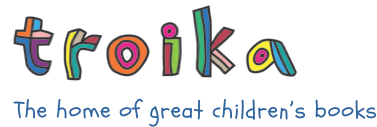‘Dog on Wheels’ goes to school: author Gillian McClure on using her picture book series to teach art, literacy and more
An idea takes shape
Gillian McClure and pupil
When I first had the idea for a series of stories about a dog on wheels named Dubbin, I had in mind toy animals on wheels. However, Dubbin’s doggie friend Todd doesn’t have wheels, nor does the other dog that follows them, and so I realised that mixing toy dogs and real dogs didn’t really work.
In this series of character roughs, you can see how I changed Dubbin (image 1 below: far left). Dubbin became a real dog (albeit with a hint of magic in the stars!)… a dog who has a skateboard, which can become a surfboard, or even a snowboard if he flips off the wheels.
The making of a picture book
When I go into primary schools, I show early sketches and roughs to Reception and Year 1 pupils to give them an idea of all the editing and preparatory work that goes into making a picture book. Here (image right), a Year 1 pupil has had a go at drawing his own character sketches of a dog on a skateboard. We talk about Dubbin and Todd’s friendship; is it unfair that Todd doesn’t have wheels and can’t keep up; can Todd be irritating; does Dubbin have to be patient and help his smaller friend?
Stimulating the senses: visuals, texture & sound
In Dog on Wheels there are refrain pages showing Dubbin rolling along on his journey (image below left). There’s lots for children to read in these pictures: the frieze running along the top, a visual summary of the dogs’ journey; another dog to spot, a visual sub-plot developing into a drama; all sorts of information on the pavements; decorative drain covers, arrows and signs (image below right). The texture of the pavements I get by dissolving rock salt crystals in watercolour wash, which some teachers are keen to try out in art lessons.
The story is in rhyme and this means that whenever Dubbin says, ‘Let’s roll!’ very young children can do actions to the jingle, ‘Two eyes, two ears and a nose, Dubbin has wheels and goes faster than feet…’ on the refrain pages.
The language of movement
Prepositions of movement come into Dubbin’s journey: down the street, under the bridge, through the gate, over the grassand the task I set Year 1 pupils is to create a new journey using other prepositions seen on this bunting that Dubbin can follow (images below left and centre).
One class teacher took the exercise further to incorporate magnets. Pupils made skateboards for all sorts of toy animals and magnets were attached to them so they could be moved about from below on the map they had drawn (image below right).
So this book, which is applicable to teaching art and literacy, can even - with a bit of ingenuity - inspire a science lesson!
Discover the complete Dog on Wheels series by Gillian McClure
For more ‘behind the scenes’ insights, visit Gillian’s website at www.gillianmcclure.com
Selkie, a Scottish Folktale
Gillian has also made a video with the National Association for Primary Education where she works with a group of year 3 and 4 children in a primary school using her book Selkie: a Scottish folktale as a teaching resource.















